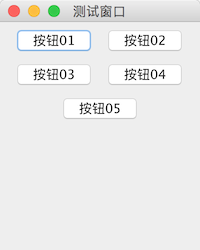JavaSwing FlowLayout 流式布局的实现
人气:01. 概述
官方JavaDocsApi: java.awt.FlowLayout
FlowLayout,流式布局管理器。按水平方向依次排列放置组件,排满一行,换下一行继续排列。排列方向(左到右 或 右到左)取决于容器的componentOrientation属性(该属性属于Component),它可能的值如下:
- ComponentOrientation.LEFT_TO_RIGHT(默认)
- ComponentOrientation.RIGHT_TO_LEFT
同一行(水平方向)的组件的对齐方式由 FlowLayout 的align属性确定,它可能的值如下:
- FlowLayout.LEFT : 左对齐
- FlowLayout.CENTER : 居中对齐(默认)
- FlowLayout.RIGHT : 右对齐
- FlowLayout.LEADING : 与容器方向的开始边对齐,例如,对于从左到右的方向,则与左边对齐
- FlowLayout.TRAILING : 与容器方向的结束边对齐,例如,对于从左到右的方向,则与右边对齐。
FlowLayout的 构造方法:
// 默认 居中对齐的,水平和垂直间隙是 5 个单位 FlowLayout() // 指定对齐方式,默认的水平和垂直间隙是 5 个单位 FlowLayout(int align) // 指定对其方式,水平 和 竖直 间隙 FlowLayout(int align, int hgap, int vgap)
2. 代码实例
package com.xiets.swing;
import javax.swing.*;
import java.awt.*;
public class Main {
public static void main(String[] args) {
JFrame jf = new JFrame("测试窗口");
jf.setSize(200, 250);
jf.setDefaultCloseOperation(WindowConstants.EXIT_ON_CLOSE);
jf.setLocationRelativeTo(null);
// 创建内容面板,指定使用 流式布局
JPanel panel = new JPanel(new FlowLayout());
JButton btn01 = new JButton("按钮01");
JButton btn02 = new JButton("按钮02");
JButton btn03 = new JButton("按钮03");
JButton btn04 = new JButton("按钮04");
JButton btn05 = new JButton("按钮05");
panel.add(btn01);
panel.add(btn02);
panel.add(btn03);
panel.add(btn04);
panel.add(btn05);
jf.setContentPane(panel);
jf.setVisible(true); // PS: 最后再设置为可显示(绘制), 所有添加的组件才会显示
}
}
结果展示:

您可能感兴趣的文章:
加载全部内容